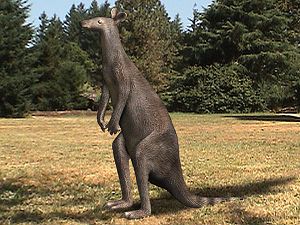- Protemnodon
-
Protemnodon 
Protemnodon anak (Lebendrekonstruktion)
Fundorte Systematik Beutelsäuger (Metatheria) Diprotodontia Macropodidae Macropodinae Gattung: Protemnodon Wissenschaftlicher Name Protemnodon Owen, 1874 Protemnodon war eine Gattung großer, ausgestorbener Kängurus. Die Tiere lebten in Australien bis ins späte Pleistozän.
Die Gattung Protemnodon war bis zum Ende des Pleistozän in Australien und Neuguinea verbreitet. Protemnodon anak ist heute die am besten bekannte Art fossiler Kängurus. Im Gegensatz zu den typischen Kurzschnauzenkängurus, die bis ins späte Pleistozän Zeitgenossen von Protemnodon waren, besaß dieses große Känguru eine relativ lange Schnauze und einen eher flachen Schädel.[1] Protemnodon anak erreichte eine Höhe von 2 m und ein Gewicht von 100 bis 150 kg. Die Art kam auch auf Tasmanien vor, wo sie etwas länger überlebt zu haben scheint, als auf dem Australischen Festland. Auf der Insel verschwand Protemnodon erst vor etwa 40.000 Jahren als letztes riesiges Känguru der Australischen Region. Tasmanien wurde auffälliger Weise erst einige tausend Jahre nach dem Australischen Kontinent durch Ureinwohner besiedelt. Ein Zusammenhang dieses Pleistozänen Massensterbens mit dem Auftreten des Menschen scheint daher naheliegend. Alternativ werden vor allem klimatische Ursachen diskutiert.[2]
Früher wurden neben ausgestorbenen Arten auch die kleineren Arten der Gattung Macropus zur Gattung Protemnodon gezählt. Die Gattung Wallabia wird als nah verwandt betrachtet.[3]
Quellen
- ↑ J. Long, M. Archer, T. Flannery, S. J. Hand, (2002): Prehistoric Mammals of Australia and New Guinea: One Hundred Million Years of Evolution. Kensington: University of New South Wales. (pg 161-162)
- ↑ Jared Diamond: Palaeontology: The last giant kangaroo. Nature 454, 835-836 (2008)
- ↑ G. D. Sanson: The Evolution and Significance of Mastication in the Macropodidae. Australian Mammal Society (1978).
Weblinks
 Commons: Protemnodon – Sammlung von Bildern, Videos und AudiodateienKategorien:
Commons: Protemnodon – Sammlung von Bildern, Videos und AudiodateienKategorien:- Kängurus
- Ausgestorbenes Säugetier
- Macropodidae
Wikimedia Foundation.
